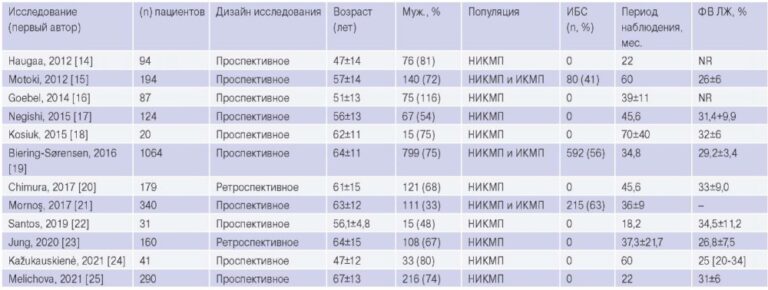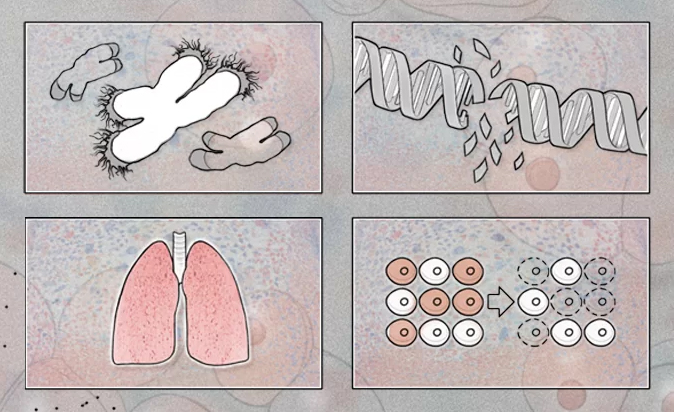Sodium-glucose co-transporter-2 inhibitors in heart failure and chronic kidney disease: the role of empagliflozin
In the case of chronic kidney disease (CKD) development in patients with cardiovascular diseases (CVD), heart failure (HF) is more frequent and more severe [1]. Conversely, the development of CKD is a risk factor not only for CVD, but also for HF [2]. The search for new drug approaches to the management of patients with HF, including in the case of CKD, is a relevant issue. More than 30 years have passed since studies using the natural glucoside phlorizin in diabetes that demonstrated glucosuric effect and later the ability to block sodium glucose cotransporters 1 and 2 (SGLT1, 2) [3]. Currently, a large number of SGLT2 inhibitors have received approval for use in clinical practice, including those approved in the United States and Europe: canagliflozin, dapagliflozin, empagliflozin and ertugliflozin, as well as ipragliflozin, luseogliflozin and tofogliflozin approved in Japan. In India, there are remogliflozin and dual SGLT1/SGLT2 inhibitor sotagliflozin, approved for use in patients with type 1 diabetes in Europe, but not yet launched for clinical use. It should be noted that for SGLT2-inhibitors, HF has recently been considered and registered as an additional indication for prescription.
Mechanisms of SGLT2-inhibitor action in the light of nephro- and cardioprotection
In a healthy person, ~180 g of glucose is filtered daily in the kidneys, while its almost complete reabsorption is observed (~99,9%). In the proximal tubule, in its initial section, where most of the SGLT2 is concentrated, up to 97% of glucose is reabsorbed, the rest is reabsorbed in the distal part of proximal tubule by SGLT1 transporters [4]. In patients with diabetes, the glomerular filtration of glucose is significantly increased, but this is accompanied by an increase in its reabsorption up to 600 g/day [5].
In addition to the glucosuric effect of SGLT2 inhibitors, they have a natriuretic and diuretic effect, which is manifested by an increase in urine volume by about 300 ml/day during the first 2-3 days and return to the initial diuresis within several weeks due to the restoration of sodium and water balance. Urine output with the use of SGLT2-inhibitors increases both with euglycemia and, to a greater extent, with hyperglycemia, and also remains elevated in stage 3-4 CKD, HF and acute HF [6].
A decrease in plasma volume during SGLT2- inhibitor therapy occurs by about 7% (5-12%) by the third month of treatment [7]. Normally, SGLT2 is responsible for the reabsorption of ~5% of sodium in tubular urine, while in diabetes the reabsorption volume increases to 15%, which is explained by an increase in SGLT2 and SGLT1 expression in proximal tubules [8]. Thus, the SGLT2 inhibition is accompanied by natriuresis. Moreover, SGLT2 inhibitors can also affect the Na+/H+ exchanger 3 (NHE3) in the proximal tubules, also reducing sodium reabsorption [9]. The effect of SGLT2 inhibitors on NHE3 can be explained by the close functional and organic relationships between SGLT2 and NHE3 [10]. In experimental models, it was shown that the use of SGLT1/SGLT2 inhibitor phlorizin markedly increases the excretion of Na+ and HCO3– in the urine. These data are consistent with in vivo stationary microperfusion of the proximal tubule, in which the addition of phlorizin to the luminal fluid sharply decreases the NHE3 activity even without glucose. This suggests that the effect of SGLT inhibition cannot be simply mediated by osmotic diuretic mechanism induced by luminal glucose. Moreover, using immunofluorescence experiments, it was shown that SGLT2, but not SGLT1, are expressed together with NHE3 on the apical membrane of proximal tubule epithelium [10]. In addition, literature data indicate the multimeric protein complexes in renal proximal tubular cells, which includes two scaffolding protein PDZK1 and MAP17 [11][12][13]. It has been shown that the MAP17 protein directly interacts with SGLT2, which is necessary for the implementation of its transport function. The MAP17 protein also interacts with PDZK1, which directly interacts with NHE3 [12].
One of SGLT2 inhibitor effects is blood pressure (BP) decrease. Systolic blood pressure in patients with type 2 diabetes and hypertension decreases by an average of 3-5 mm Hg, diastolic — by 1-2 mm Hg [14]. Moreover, this effect remains in full in patients, despite a decrease in renal function [15].
One of the key effects of SGLT2 inhibitors, explaining their nephroprotective effect, is the effect on glomerular filtration. Through SGLT2, not only glucose is reabsorbed, but also sodium. In the case of SGLT2 inhibition, the sodium concentration in the primary urine increases, which effect the juxtaglomerular apparatus (macula densa) in distal tubule. This, in turn, leads to the release of adenosine triphosphate from juxtaglomerular apparatus cells, which is degraded to adenosine. Adenosine effects the adenosine A1 receptors in afferent arteriole wall, which is accompanied by its contraction and pressure decrease, as well as suppression of hyperfiltration in the renal glomerulus. To a lesser extent, the effect of adenosine on A2 receptors in the efferent arteriole, the activation of which is accompanied by vascular dilatation, has been shown [16][17].
The use of SGLT2 inhibitors is accompanied by a decrease in albuminuria. The meta-analysis of 48 randomized clinical trials on SGLT2 inhibitors’ use for >12 weeks, including 50 thousand patients, showed a decrease in albumin-to-creatinine ratio (weighted average difference, -14,6 mg/g, p=0,006), with more pronounced effect in subjects with a higher baseline albumin-to-creatinine ratio [18]. In particular, a decrease in the risk of microalbuminuria (relative risk (RR), 0,69, p=0,032), macroalbuminuria (RR, 0,49, p<0,001), nephropathy progression (RR, 0,73, p=0,012) and end-stage renal failure (RR, 0,70, p=0,001).
In recent years, the focus from hyperfiltration as an independent factor in renal parenchyma damage is gradually shifting to the proximal tubules. Hyperfiltration is considered as a factor in increasing the functional load on the proximal tubular epithelium, which leads to its damage. And damage to the proximal tubular epithelium can be considered as a key universal mechanism of kidney damage not only in diabetes, but also in a number of other pathological processes that occur with hyperfiltration phenomena. With the use of SGLT2 inhibitors, due to the relief of hyperfiltration, the transport load on the proximal tubules decreases. However, a direct nephroprotective effect of these rugs on the tubular epithelium has also been shown.
The ability of SGLT2 inhibitors to suppress the peroxidation in mitochondria of the proximal tubular epithelium has been shown [19][20]. Hyperglycemia in diabetes and renin-angiotensin-aldostenorone system activation can cause inflammatory reactions, as well as hyperproduction of reactive oxygen species in proximal tubular cells, and these effects are suppressed by SGLT2 inhibitors [21]. During therapy, there is a decrease in the expression of inflammation genes in the renal tissue, as well as the reduction of oxidative stress [22]. The anti-inflammatory effects of SGLT2 inhibitors are manifested in a decrease in interleukin-6 level and tumour necrosis factor in the blood, as well as nuclear factor-kB and interleukin-6 in the renal tissue of rats with diabetes [16][23].
SGLT2 inhibitor action increases the reabsorption load in the lower tubular areas, which consume a smaller oxygen volume. This leads to the activation of hypoxia inducible factor (HIF)-dependent processes with a subsequent increase in the production of erythropoietins and improved oxygen delivery to the renal tissue [24]. This mechanism is also considered as a possible tubular protective effect of SGLT2 inhibitors.
SGLT2 inhibitor therapy is accompanied by decreased leptin production, as well as a decrease in fat deposition in the perivisceral, pericardial, and perivascular spaces, which may contribute in improving the course of metabolic processes [25, 26].
SGLT2 inhibitors also lead to a decrease in blood uric acid level due to a decrease in urate reabsorption by proximal tubular epithelium through GLUT9b [27]. Large meta-analysis of 62 clinical studies on SGLT2 inhibitors showed that blood uric acid level decreased by about 35-45 ?mol/L, while the effect developed quickly and persisted throughout the treatment period [28].
The cardioprotective effect of SGLT2 inhibitors is explained by different ways. Despite the fact that cardiomyocytes do not express SGLT2, SGLT2 inhibitors are able to directly effect cardiomyocytes by affecting NHE1. An increase in its activity is shown in HF, which leads to an sodium and calcium increase in cardiomyocyte cytoplasm and may be associated with the activation of oxidative stress in arrhythmias [29]. Accordingly, in vitro use of SGLT2 inhibitor empagliflozin has demonstrated the ability to inhibit NHE1 in cardiomyocytes, reducing intracellular sodium and calcium levels [30]. Most of the cardioprotective effects of SGLT2 inhibitors are mediated. Among them are the sodium diuretic effect, a decrease in the number of glycation products with pro-inflammatory and endotheliotoxic properties, the normalization of carbohydrate metabolism, a decrease in blood pressure and body weight, etc [31]. The use of SGLT2 inhibitors is accompanied by a decrease in intrarenal reninangiotensin-aldostenorone system activity, as well as a decrease in plasma renin secretion [32][33][34].
Another putative organ protective action of SGLT2 inhibitors is their ability to inhibit the sympathetic nervous system. Sympathetic hyperactivity in the proximal tubule area is associated with impaired renal regulation of glucose, sodium, and water [35]. The argument in favor of this mechanism is that renal sympathetic denervation in OLETF rats with diabetes improved glucose metabolism, which was explained by an increase in its urine excretion due to SGLT2 suppression [36]. Stimulation of the renal sympathetic innervation resulted in NHE3 hyperactivity in the apical membrane of the proximal tubule, which was accompanied by antinatriuretic and antidiuretic effects [37]. In turn, in experimental models, SGLT2 inhibitors reduce sympathetic activity in the kidneys and heart [38].
Thus, the cardioprotective effect of SGLT2 inhibitors in HF is realized both through a direct effect on cardiomyocytes and an indirect effect (diuretic, hypotensive effects, sympathetic nervous system suppression, effective treatment of type 2 diabetes). Renoprotective effect of SGLT2 inhibitors in HF is a guarantee of a beneficial effect on the cardiorenal continuum.
Results of studies on empagliflozin use in HF and CKD
The randomized, double-blind, placebo-controlled study EMPA-REG OUTCOME evaluated the effects of empagliflozin at a dose of 10 mg or 25 mg once a day compared with placebo on cardiovascular events in adults with type 2 diabetes, high cardiovascular risk and a glomerular filtration rate >30 ml/min/1,73 m2 [39]. It was shown that in patients with type 2 diabetes and concomitant CVD, the use of empagliflozin led to a 35% decrease in hospitalization risk due to decompensated HF, as well as (in subgroup analyses) to an improvement in HF outcomes, such as the risk of loop diuretics’ introduction and HF-related rehospitalization [40]. There was also an early and sustained 38% relative reduction in the cardiovascular death risk, regardless of baseline renal function. In patients with type 2 diabetes and CVD, empagliflozin therapy led to a rapid 59% reduction in the relative risk of development or progression of nephropathy, a 44% relative risk of doubling serum creatinine, and a 55% risk of initiating renal replacement therapy compared with placebo [41]. Also, the incidence of adverse events associated with acute kidney injury was lower in the empagliflozin group than in the placebo one.
It should be noted that the positive effect of empagliflozin on cardiovascular mortality and HFrelated hospitalizations persisted regardless of CVDs such as heart failure [40], atrial fibrillation [42] (B?hm M, et al., 2020), kidney disease [41], as well as ongoing antihyperglycemic therapy [40].
Empagliflozin continues to be studied in the EMPOWER program, which includes patients with HF, CKD, and myocardial infarction. Thus, the double-blind placebo-controlled study EMPERORReduced on empagliflozin therapy at a dose of 10 mg in patients with reduced ejection fraction (EF) compared with placebo was conducted. The study included 3730 patients with an mean age of 67 years (female, 24%): 75% of patients had NYHA class II HF, 24% — class III and <1% — class IV. Half of the patients had a history of type 2 diabetes, 73% had a left ventricular ejection fraction of 30% or less, 79% had an N-terminal pro-brain natriuretic peptide (NT-proBNP) of at least 1000 pg/ml, 48% had an estimated glomerular filtration rate (eGFR) <60 ml/ min/1,73 m2, and almost 20% of patients received sacubitril/valsartan [43]. It is important to note that the researchers planned in advance to include severe patients with LVEF <30%, and those hospitalized due to decompensated HF within prior 12 months or having high NT-proBNP levels, as well as eGFR >20 ml/min/1,73 m2 .
The primary endpoint (cardiovascular mortality or HF-related hospitalization) was less common by 25% in the empagliflozin group compared with placebo, and primary or repeated hospitalizations due to HF — 30% less frequently [43]. It should be noted that the positive effect of empagliflozin on the primary endpoint was observed regardless of presence/ absence of diabetes, baseline renal function, and initial therapy with mineralocorticoid receptor antagonists or angiotensin receptor blocker neprilysin.
One of the secondary endpoints was eGFR decline over the study. The difference in eGFR decrease in the empagliflozin group compared with placebo was 1,73 ml/min per year (p<0,001) in favour of the SGLT2 inhibitor. Empagliflozin therapy in patients with HF reduced the risk of composite renal endpoint by 50% (initiation of renal replacement therapy, kidney transplantation, or stable decrease in eGFR >40% of the baseline) — RR, 0,50 (95% confidence interval, 0,32-0,77).
According to the EMPEROR-Reduced study results, empagliflozin showed a favorable safety profile without cases of ketoacidosis, and the incidence of hypoglycemia was comparable to placebo. In addition, there were no significant differences with the placebo group in adverse events, including hypovolemia, hypotension, renal impairment, hyperkalemia.
The results of this study open up additional prospects for empagliflozin use in patients with HF without diabetes, including with reduced renal function and regardless of a number of drugs used for HF therapy.
The results of the ongoing EMPA-KIDNEY study in adult patients with documented CKD should be expected within a year. This study investigates the nephroprotective and cardioprotective efficacy of empagliflozin in patients with GFR >20 ml/min [44]. Obtaining information on the effect of empagliflozin in this study will provide additional information about its effectiveness in patients with CKD and HF.
Conclusion
SGLT2-inhibitors have a number of direct and indirect cardio- and nephroprotective effects, ensuring the effectiveness of their use in HF, including in patients with CKD. Research results show that empagliflozin is effective in reducing the risk of cardiovascular death and HF-related hospitalizations in patients with type 2 diabetes and CVD, and these effects persist in different patient subgroups. In patients with HF with reduced EF, empagliflozin has also been shown to be effective in reducing the risk of HF-related hospitalizations and cardiovascular death, as well as in slowing the renal function decline compared with placebo. Thus, empagliflozin prevents the CVD progression in patients with type 2 diabetes and those with heart failure with reduced ejection fraction, regardless of diabetes.
The EMPOWER program will expand the variety of empagliflozin effects in patients where modern therapy has serious limitations.
Чтобы читать статью войдите с логином и паролем от scardio.ru
Keywords
For citation
Batyushin M.M. Sodium-glucose co-transporter-2 inhibitors in heart failure and chronic kidney disease: the role of empagliflozin. Russian Journal of Cardiology. 2021;26(1S):4349. (In Russ.) https://doi.org/10.15829/1560-4071-2021-4349
Copy




